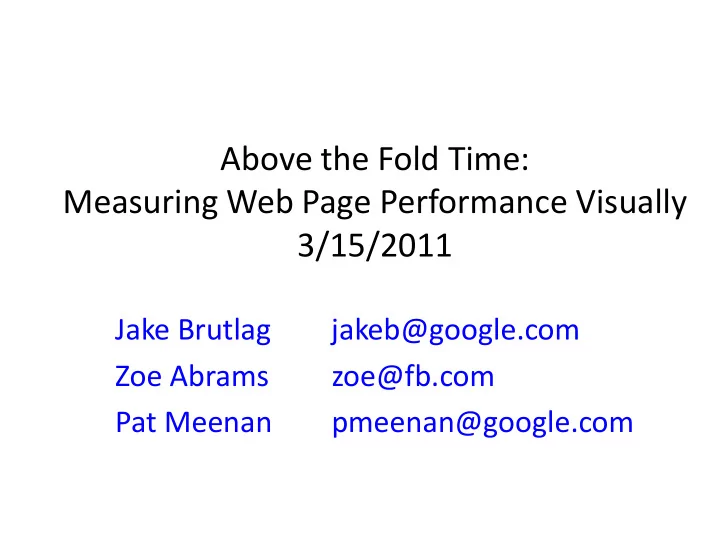

Above the Fold Time: Measuring Web Page Performance Visually 3/15/2011 Jake Brutlag jakeb@google.com Zoe Abrams zoe@fb.com Pat Meenan pmeenan@google.com
When is the page rendered? Q: How fast is your web page? One answer: How long does it take the user to see all visible content? AFT Above the Fold Time (AFT): Time when content that stops changing and is above-the-fold reaches its final state.
Browser events Page load time (PLT): start of navigation until browser Onload event (IE DocumentComplete) for document Can overestimate above-the-fold time PLT AFT Can underestimate above-the-fold time PLT AFT
deviantart.com overestimate AFT PLT Below the fold (not visible) content pushes out Onload
att.com underestimate PLT AFT Above-the-fold content loaded by JS and Flash occurs after Onload
Browser events are not cross-browser Difference is not primarily a rendering difference. But JS blocking for Onload in FF, non-blocking for IE.
Estimating AFT (1) Naïve: AFT = time of the last pixel change above-the-fold Challenge: Animation/video = pixels keep changing
Estimating AFT (2) • Specify an upper bound, the AFT cutoff time, on the page load – Function of connection speed/quality, i.e. 45 s for DSL • Classify pixels as static or dynamic – Static = pixels that change < 5 times and don’t change after AFT cutoff – Dynamic = pixels that change ≥ 5 times and keep changing after AFT cutoff – Capture video for period > AFT cutoff to identify dynamic pixels with confidence • AFT = latest change of a static pixel before the AFT cutoff
AFT for att.com Black = unpainted pixels White = static pixels Blue = dynamic pixels Green = last static pixels to change → AFT Rotating content panel = dynamic pixels AFT is defined by the Pause button. Button rendered once panel is initialized.
5 pixel change heuristic Alexa Top 200 Home Pages, % of Pixels Rendered by # of Pixel Changes 90% pixels rendered in the Alexa Top 200 home pages change fewer than 5 times. Similar pattern for DSL and Dialup, despite more progressive rendering on Dialup.
http://www.webpagetest.org
wait 4 minutes…
Key Screen Shots. In this example, OnLoad (DocumentComplete) does not include lower right panel. AFT often agrees with Onload/DocumentComplete or Fully Loaded (= all resources fetched).
ebay.com example not ignoring small changes Black = unpainted pixels White = static pixels Blue = dynamic pixels Red = Pixels that change < 5 times with last change after the AFT cutoff → AFT is N/A. Page has “daily deal” timer: 11h 41m 46s Minutes are updated after AFT cutoff.
Wrap up • Applications of AFT – Visual measure of page performance – Cross-browser metric – Validation of other metrics (i.e. JS metrics) • Limitations of AFT – Only applicable to lab setting – Does not reflect user perceived latency based on functionality • AFT heuristics always need further iteration – http://www.webpagetest.org/forums/
Ambiguous Cases for Estimating AFT • One time animation: pixels that change ≥ 5 times but don’t change after the AFT cutoff. – Should one time animation be included in AFT? – Current algorithm: No. • Pixels that change < 5 times with last change after the AFT cutoff. – Perhaps AFT cutoff needs to be extended – tmz.com example • AFT may be decided by small (perhaps not user visible) changes. – Previous ebay.com example
tmz.com example DSL, AFT Cutoff=25 s Red = Pixels that change < 5 times with last change after the AFT cutoff → AFT is N/A. Cause: Like button forces frame flow re-render (pushes content down) at 40 s. Solution: Increase AFT cutoff from 25 s to 45 s to include this re-render in AFT.
Recommend
More recommend